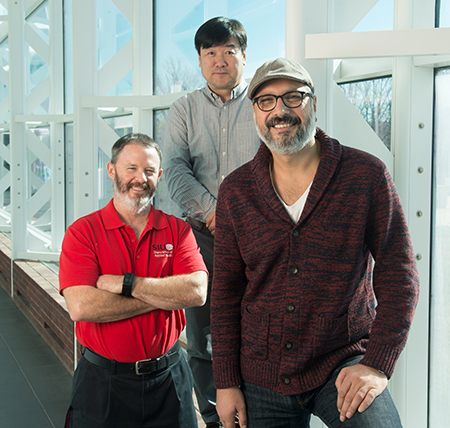 Southern Illinois University Edwardsville will soon house the first comprehensive motion capture and analysis system (MCAS) to serve the Southwestern Illinois and Eastern Missouri area, through a $185,358 grant from the National Science Foundation’s Major Research Instrumentation (NSF MRI) program.
Southern Illinois University Edwardsville will soon house the first comprehensive motion capture and analysis system (MCAS) to serve the Southwestern Illinois and Eastern Missouri area, through a $185,358 grant from the National Science Foundation’s Major Research Instrumentation (NSF MRI) program.
The innovative technology system will be a core research and educational platform for complex body movement analysis in medicine, sports and occupational safety.
“Motion capture and analysis systems record the movement of objects or people, which can be analyzed or modified using computer software,” said lead principal investigator Sinan Onal, PhD, assistant professor in the SIUE School of Engineering (SOE) Department of Mechanical and Industrial Engineering. “It has found applications in the military, healthcare, sports, visual arts, video gaming, filmmaking and robotics industries. Specifically, it has improved the quality of healthcare in numerous ways.”
Onal and five other SIU System faculty members are collaborating on the proposed project, combining expertise in methods design for work places, medical imaging and analysis, exercise physiology, biomechanics, surgical techniques and dental impact surgery. Along with Onal, the researchers include:
- Sohyung Cho, PhD, professor in the SIUE SOE Department of Mechanical and Industrial Engineering
- Bryan Smith, PhD, associate professor in the School of Education, Health and Human Behavior (SEHHB) Department of Applied Health and certified strength and conditioning specialist
- Mohamed Omran, BDS, MSC, assistant professor in the SIU School of Dental Medicine Department of Graduate Education, section of Implantology
- Michael Neumeister, MD, professor and chairman in the SIU School of Medicine Department of Surgery and Department of Orthopedics
- Ashim Gupta, PhD, research assistant professor in the SIU School of Medicine
“For many years, the lack of state-of-the-art research instrumentation in this region has inhibited cutting-edge research on motion analysis in medicine, sports and visual art areas,” Onal added. “This MCAS system will serve not only approximately 2,500 students in the SIUE Schools of Engineering and Education, Health and Human behavior, but also the SIU System, and other universities in the area, including Washington University, Saint Louis University, University of Missouri-St. Louis, Webster University and McKendree University.”
Various motion capture systems have been developed in the last few decades, which can be categorized into three main types: magnetic, mechanical and optical systems. SIUE is acquiring the major components required to construct an optical-based MCAS. This type of system is the least limiting and most commonly used.
“In optical systems, reflective markers or light-emitting devices are attached to the human body and along with images captured by cameras, enable the computation of three-dimensional locations,” Onal said. “Our specific aim is to conduct both research and teaching focused on performance improvement techniques to prevent injury, especially in workers, surgeons and athletes.”
The system will bolster interdisciplinary research in engineering, exercise physiology medicine, athletics and arts. It will support the graduate programs in engineering and applied health by facilitating the characterization and analysis of motion.
As the only school in the region to offer an industrial engineering program, the SIUE SOE is positioned to become the academic leader for educating the community about motion capture and analysis technology through hands-on workshops.
“This new laboratory is expected to attract the attention of high school students and teachers through summer programs conducted at SIUE,” Onal said. “In a six-week program, SIUE will offer high-ability secondary school students and teachers the opportunity to directly participate in the laboratory and conduct research projects focused on biomechanics and movement analyses.”
With the acquisition, the researchers have proposed to introduce a senior level, hands-on elective course on motion analysis, and add the MCAS as an integral part of existing courses, such as biomechanics, qualitative analysis of medical images, and methods design and work measurements, to expose students to various motion analysis techniques and applications.
Through innovative collaborations using the MCAS, Onal expects new lines of research to emerge and stimulate new grant proposals, jointly authored papers and educational exchanges among students and faculty from multiple campuses and institutions.
The project is in phase one with lab space preparation and system procurement. By August 2018, the research team expects to hold an open house and issue its NSF MRI final report.
Photo: (L-R) Dr. Bryan Smith, Dr. Soyhung Cho and Dr. Sinan Onal.